BY DAVID THOMSON
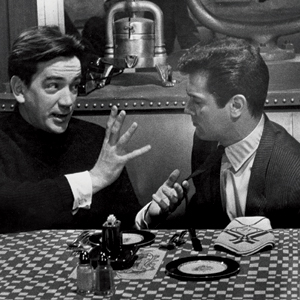 NIGHTLIFE: Mackendrick directs Tony Curtis as loathsome press
NIGHTLIFE: Mackendrick directs Tony Curtis as loathsome press
agent Sidney Falco in Sweet Smell of Success.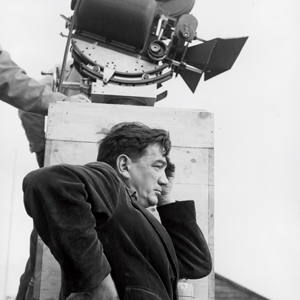 On the set of Sammy Going South. (Photo Credits: BFI)
On the set of Sammy Going South. (Photo Credits: BFI)Alexander Mackendrick is "known" these days for one movie above all, and for his bold decision to opt out of filmmaking itself and teach the strange alchemy of directing film. The movie is Sweet Smell of Success, such an exultant, acidic view of a certain kind of American life—the nocturnal city of hustling rats—that it was easy for everyone to assume the director was Scottish, or British, and that he had come to America with a disapproving yet eager gaze (like the mood in which John Boorman would make Point Blank about 10 years later).
But Mackendrick was American too, born in Boston in 1912, a year after his parents arrived from Glasgow. The father, Francis, was a shipbuilder and an engineer in the great age of such things. He died in the influenza scourge of 1919, and left his wife, Martha, in such poverty that she asked her father to take the boy back to Glasgow and raise him there. This was not an uncommon story in times of perilous survival, but Mackendrick went back to Scotland and saw his mother very rarely. She died during the Second World War, and he never knew what happened to her—or whether he had been secretly responsible for the breakup of the family.
Straightaway, anyone familiar with his work sits up and takes notice, for Mackendrick is a director fascinated by, yet unsentimental about, childhood. He liked child actors because they believed in stories more deeply, but had an uncommon sense of how tough and lonely kids have to be. Mandy (1952), Sammy Going South (1963), and A High Wind in Jamaica (1965) are films that center on children but with a startling lack of routine fondness for them. But these days how many people have seen those films, compared with Sweet Smell of Success?
It is the story of a city under the eye and the influence of J.J. Hunsecker (Burt Lancaster), a gossip columnist based on Walter Winchell, but made harsh by Lancaster's cropped hair and horn-rimmed spectacles. One of his slaves is Sidney Falco (Tony Curtis), a publicity agent who tries to get stories in the Hunsecker column. In a strange, eerie way, it's a father-son story but the bloodline is poisoned—Hunsecker calls Sidney "a cookie laced with arsenic."
However much he is linked to Manhattan at night and the raw stink of ambition, there was a Scot in Sandy Mackendrick. He lived in Britain from the early '20s to the mid-'50s. He was a Glasgow kid, raised by aunts, when Glasgow was the poorest and most brutal city in Britain, and was a student at the Glasgow School of Art. From Glasgow, Mackendrick went to work as a commercial artist in advertising, and it was thus that he was drawn into British film in the late '30s.
With his cousin, Roger MacDougall, he wrote a script that was purchased—though apparently Mackendrick kept no credit. He then worked as a writer and assistant to the team of John Halas and Joy Batchelor, who were making experimental cartoon films. But in 1943, Mackendrick was promoted to the Psychological Warfare Division of the Ministry of Information. He was sent to Italy after it had been invaded and played a part in the making of Roberto Rossellini's Rome, Open City. Shot on odd scraps of film, sometimes under the shadow of German occupation, yet with scenes of searing power (remember the shooting of the Anna Magnani figure?), Open City was an astonishing influence on the would-be teacher.
As a screenwriter, Mackendrick worked on Basil Dearden's Saraband for Dead Lovers (a costume romance), and two features with a documentary feeling, Dearden's The Blue Lamp (a tribute to the police) and Charles Crichton's Dance Hall (about young women who go dancing at the local palais). These films have dated, but just as Dance Hall has a gritty sense of reality, The Blue Lamp, when it turns to its hoodlum character (played by a young Dirk Bogarde), is startlingly candid and nasty.
It was at this point that Balcon offered Mackendrick a prime property for a directing debut—the Compton Mackenzie novel that would be known as Whisky Galore! in Britain and Tight Little Island in the U.S. It's a classic Ealing comedy with the government and its minions being run ragged by cunning, thirsty locals in the Scottish highlands who seek to plunder a ship that has wrecked with its cargo of whisky. Mackendrick went on location to the Scottish island of Barra, and the film was a hit on both sides of the Atlantic, even if it says more about Ealing (with its anti-authoritarian attitudes) than it does about Mackendrick.
All of a sudden, the orphan figure was set up. For his second film, he and MacDougall adapted the latter's play, The Man in the White Suit. A comedy with a dark edge, it's the story of a detached, dreamy chemical genius (Alec Guinness) who invents a fabric that won't wear out—and all the vested and suited interests that oppose his plans. Mackendrick displayed a Swiftian distaste for owners and unions alike in the way they want to block progress, and as shot by Douglas Slocombe, the film had a noir mood. But the picture was too sharp in tone to be a popular smash.
A year later in 1952, Mackendrick made Mandy (known as Crash of Silence in America). This was the story of a deaf child—at which alarm signals might easily sound, for in Britain at that time one would anticipate an unrestrained weepie on such a subject. But Mandy Miller, an unusual child actress who had also been in The Man in the White Suit, made the little girl odd and difficult, not sweet and adorable, and Jack Hawkins as her doctor is a man caught in a love affair. So it wasn't what audiences expected. You'd have to say the same thing about the two films that followed it - The Maggie (1954) and The Ladykillers (1955). The first is about a stupid American loudmouth (played by Paul Douglas) being humiliated by Scottish intrigue. In the other, a gang of criminals do their plotting in a house near a London railway station only to be outwitted by the old lady who owns the house. The killers included Alec Guinness, Herbert Lom and a young Peter Sellers. Shot in pale, urbanized color, it is a very black comedy (much more so than the Coen Brothers remake), and it was another big hit.
So Mackendrick was 43, tall, handsome and full of charm, the director of five films in a row, two of which had made a lot of money and two of which had received screenplay Oscar nominations. Plus, he was an American citizen, even if most of what he knew about that country came from the movies. So when Ealing collapsed in 1955, he went to America having heard that Cary Grant wanted to do a remake of Mandy. But then he was put under contract by the new production company of Hecht-Hill-Lancaster, which had just won a best picture Oscar for Marty. Mackendrick's first assignment was to direct Sweet Smell of Success, from an Ernest Lehman story and script, with hurried rewrites from Clifford Odets.
Everyone treasures—and quotes—that language. (For instance: having executed one of Hunsecker's evil errands, Falco reports back, "The cat's in the bag and the bag's in the river.") But it's easy to forget that a Scot was in charge of it. Mackendrick had not been in America since childhood, but somehow he knew or felt this talk and challenged his stars to go with it. Hard-boiled talk was never the same again, and maybe Lancaster and Curtis were a little alarmed at the unrelenting portraits Mackendrick had secured.
Sweet Smell was not a success when it opened and gathered zero Academy nominations—not for Curtis or Lancaster, not even for James Wong Howe's unprecedented night photography. That's how unexpected the film was, in its scabrous view of a gossip columnist, the PR man who feeds him stories and the whole panorama of Manhattan as a paranoid jungle. This came at a moment when being un-American was still dangerous.
The first thought was to have Orson Welles play J.J. Hunsecker, until Burt sat up at one meeting and asked, "What about me?" It was an intimidating wish, and the newcomer Mackendrick did not have the easiest time standing up to his boss. The picture has its flaws: the role of Hunsecker's kid sister doesn't quite work, and the second-half plot is a desperate search for tidiness. But when J.J. and Sidney are together, caught up in their lethal backchat, the film is electric. Above all, it gave the impression of being made by someone who knew that dark world, and loved it as much as he loathed it—it could have been John Huston directing.
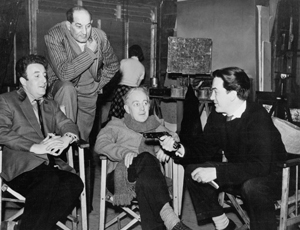 On his first feature,Whisky Galore! (Photo Credit: BFI)
On his first feature,Whisky Galore! (Photo Credit: BFI)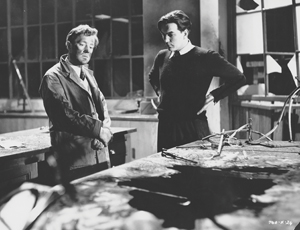 Directing Alec Guinness in The Man in the White Suit. (Photo: BFI)
Directing Alec Guinness in The Man in the White Suit. (Photo: BFI)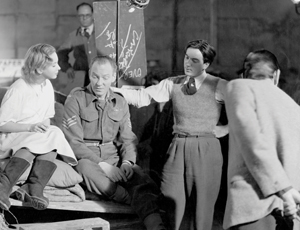 On the set of The Ladykillers. (Photo: BFI)
On the set of The Ladykillers. (Photo: BFI)A critical success that made no money, Sweet Smell also carried stories of Mackendrick's intense perfectionism angering producers. There are others who say that "perfectionism" was another way of saying that as production drew nearer, Mackendrick grew increasingly tense—even to the point of a semi-breakdown. Lancaster never worked with him again. Indeed, it was Burt who apparently got Mackendrick off The Devil's Disciple (Guy Hamilton took over).
Two years later, some mixture of back trouble and striving for a mythic vision got Mackendrick removed from The Guns of Navarone by writer-producer Carl Foreman just as shooting began. Yet he had prepared and helped write that epic for a full year. His son, John Mackendrick, recalls, "It was a great blow and it led to a serious depression in my father. But there were disagreements over cast and location. He wanted to do as much as he could away from the studio. He had wanted Cary Grant, and Columbia refused. He had also wanted Grant for Dr. No when he was asked to do the first Bond film."
So many people felt Sandy's talent—thus the range of ideas and projects that came his way. But his mounting nervousness so often got in the way, and for some observers this was the legacy of that protective Ealing training. Yet Mackendrick was now out in a world where directors had to develop projects and stay patient with the business.
With Navarone and Dr. No, Mackendrick would have been a major director. But he would get only three more credits: Sammy Going South, in which Edward G. Robinson and an orphan boy walk through Africa; A High Wind in Jamaica, an adaptation of the Richard Hughes novel in which a group of boys are captured by amiable pirates, only to destroy the wild men. There was also a comedy, Don't Make Waves, which reunited the director with Tony Curtis. But A High Wind in Jamaica stands out—with Anthony Quinn and James Coburn as pirates, and the kids perceived as casual masters of their own malice.
You might have thought that in the '60s, Mackendrick would have gone back to Britain. There was a near miss. The new company, Woodfall Films, co-founded by Tony Richardson and John Osborne, approached him about directing Tony Hancock, the radio comedian, in a film version of the Eugène Ionesco play, Rhinocéros. It was agreed. Clive Exton was doing a script while Hancock and Mackendrick tried to persuade Zero Mostel to take a supporting role. Mostel refused. Hancock started drinking. The actor had lost all confidence and Mackendrick didn't know how to supply it. The project fell through, and Mackendrick elected to settle in Los Angeles.
There must have been other dreams and plans—for decades he had wanted to do a life of Mary, Queen of Scots, someone who never quite decided whether she was French or Scottish. In 1969, he surprised many people by taking on the job of Dean of Film at the California School of Arts (CalArts), a prestigious school launched by Walt Disney in the wooded hills north of Los Angeles. And so the perfectionist became a teacher. It doesn't sound quite right, but Mackendrick taught for over two decades and had a profound influence on many young people. (Director James Mangold paid tribute to his teacher in the spring 2008 DGA Quarterly; another of his students, Thom Mount, became a studio boss at Universal.)
CalArts was a long way from the film factories, USC and UCLA. It was a stronghold of experimental thinking, and Mackendrick felt the new cult of the director as auteur was hopelessly unrealistic. He believed in a filmmaker as a flexible spirit ready for the huge changes that overtook the film business every seven years or so.
There was a book, On Filmmaking: An Introduction to the Craft of the Director, compiled from Mackendrick's lectures, edited by Paul Cronin, full of careful advice about story, character and script—sensible, old-fashioned and bruised from experience. It was a useful, deeply felt book and it stressed that old lesson that you will learn the most—for good and ill—only as you come to make a film. Cronin sees now that there was "a perpetually troubled, cynical man in Sandy." He was an inspiring teacher but how much did he believe in the whole thing himself? When the Museum of Modern Art in New York gave Mackendrick a tribute in 2005, they titled it "Auteur and Academic." Yet as Cronin sees it, the charm, the danger and importance of Mackendrick was in refusing to be either.
Mackendrick died in 1993, and is buried in Los Angeles. Fair enough: he made one film that changed the way American films thought of their own land. But he was a complicated man with an unhappy history, and if you can get to see all of his films, then his progress becomes plainer and all the sadder. Ever since the business and the art began their wrestling match, it has been a hard thing to keep the career of a film director going and to make sure the work improves. Sandy Mackendrick may have felt he was a lifelong misfit. To which we can only add the burning cryptic moment when Hunsecker pulls out a cigarette and gives his hushed order, "Match me, Sidney," and from somewhere the rat finds the courage to defy his master. Years later, looking back on Sweet Smell of Success, Mackendrick concluded, "The moments of your greatest fear are also the moments you look back on as your greatest thrill. The danger is an aphrodisiac. It must be." Sweet Smell is still like a slap in the face that says, "Wake up! This is how the world is."